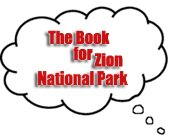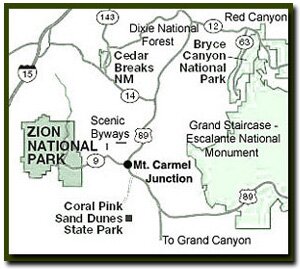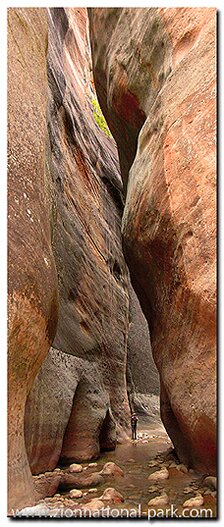
|
||||
|
Zion National Park Lodging Park Info Vacation Weather Photos Hike SR-9 Slots Backpack Camping |
||||
Geology of Lower Zion Canyon
Geology of Lower Zion Canyon - Rock turns from hoodoos and slickrock mountains to towering vertical cliffs as the road travels through the Zion-Mt. Carmel Tunnel from the east. When traveling down the six switchbacks, look for the Great Arch. The end of the Canyon Overlook Trail is directly above this blind arch. This indentation in the mountain side was formed by jointing, creating the impressive arched structure. It is estimated that around thirteen-million years ago the southern Colorado Plateau rose up and broke into distinct table lands. Through vast changes in time, the acres of land that are now Zion were carved and molded by harsh storms blasting away at the sandstone. This sort of blind arch is found throughout the park but only the Great Arch and Red Arch Mountain are named. On the south side of the Zion-Mt. Carmel Tunnel there is a rapid drop as the narrow road travels down the zigzagging switchbacks to the bottom of the canyon floor, leading to Kayenta formations and towering Navajo sandstone. The carved out area at the bottom of the switchbacks is known as Lower Zion Canyon. The white sandstone turrets that top the Beehives, (6904 feet) are seen here. Located directly behind the Zion Human History Museum is the West Temple at 7810 feet, the Sundial at 7590 feet and the Altar of Sacrifice at 7505 feet. 
Geology of Zion Canyon - The North Fork of the Virgin River flows through much of the park and actually carved and continues to expand the Zion Canyon you see today. Starting at Cascade Falls on Cedar Mountain in Dixie National Forest, at 9000 feet, the water begins to flow and pick up sediment as it makes its way through the Zion Narrows. Many tributaries flow into the narrows contributing sediment and momentum. When hiking the Narrows, it seems mild, but that stream is capable of transporting tons of debris 200 miles downstream to a 1000 foot elevation in Lake Mead, Nevada. All this however only contributes to about ten-percent of the erosion; ninety-percent is accomplished by flash floods. Once the water leaves the Narrows at the Temple of Sinawava, it reaches the softer Kayenta Formation and erodes the shale, so the overlaying sandstone collapses, resulting in a wider canyon from that point on in Zion Canyon.
Natural Arches in Zion National Park - A natural arch is created by natural geological forces causing rock to fall leaving an arch structure standing. When sandstone falls, it usually explodes or vaporizes leaving little trace of its existence. A natural bridge, on the other hand, is caused by water that erodes rock, creating the formation. Kolob Arch in Zion National Park is the world's second longest natural arch measuring 294 feet. There are a few other natural arches in Zion including two on Bridge Mountain – Crawford Arch and Hepworth Arch. Crawford Arch can be seen from a distance from the Pa'rus Trail or the front steps on the Zion Human History Museum. Other natural arches include Two Pines Arch, Hidden Canyon Arch, Jug Handle Arch, Checkerboard Arch, Hidden Arch and Pico Rosado Arch. There are also some arches in Zion’s slot canyons including: Subway, Fat Man's Misery, Spry Canyon, Pine Creek Canyon, Englestead Hollow, Imlay Canyon, Heaps Canyon and Eye of the Needle. Arches such as Hammerhead and Elephant can be found in remote parts of the park. Crawford Arch on Bridge Mountain – If you stand at the interpretive sign in front of the Zion Human History Museum you can see this 427 foot long arch on the west side of Bridge Mountain. The photo shown on the interpretive sign was taken in the 1930’s and has a man standing on the top of the arch. The man gives those who do not, or cannot undertake the grueling hike up Bridge Mountain to the arch the size of it.
Zion National Park, UtahHistory of the Thunderbird |
East Zion Lodge Mileage from Stay in a hotel the heart of the parks, Mount Carmel Junction, and visit the treasures of the Southwest and Utah. Site Map Zion Hiking
|
||||||||||||
|
This is my new favorite quote:
"I don't know who Mary Cisneros is, but I mean zionnational-park.com It's a better site than the NPS's anyway." Written by the authors of the book: Favorite Hikes in and around Zion National Park |
|||||||||||||
|
Zion History |
|---|
All rights reserved © Copyright Zion National-Park dot com
Do not use text, photos or maps without permission © Zion National-Park dot com
Contact the Author Mary Cisneros with any errors




